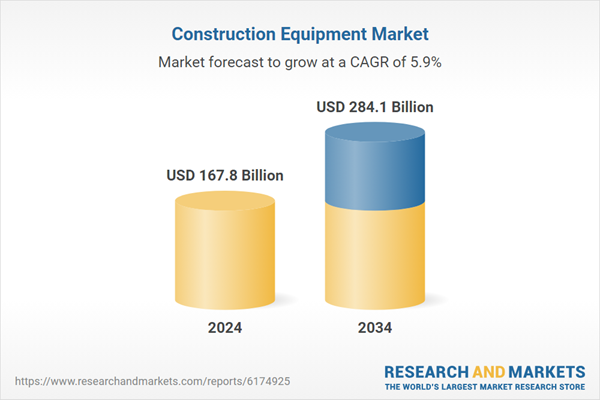The growth is driven by the rising infrastructure development and urbanization. Governments are investing heavily in infrastructure such as roads, bridges, airports, and railways to boost economic growth and improve connectivity. This increase in construction demands advanced machinery, increasing the demand for construction equipment. The integration of technological advancements such as AI and IoT into manufacturing devices is increasing productivity and safety, making these devices more attractive to manufacturing companies.
The rise in private sector investments and real estate development will also influence market growth. As industry expands and new industries emerge, the need for retail, industrial, and construction work increases. This increases the demand for construction equipment, ranging from excavators and forklifts to cranes and bulldozers. The shift towards industrialization in agriculture and mining is important, as these industries require specialized equipment to be efficient.
The earthmoving and road-building equipment segment held a 57% share in 2024 and is forecasted to grow at a CAGR of 5% between 2025 and 2034. This segment, which includes machinery such as backhoes, excavators, loaders, and compactors, is poised for accelerated growth due to increasing investments in public infrastructure and the rapid execution of road development projects by governments worldwide. The surge in demand for efficient road transportation systems and better connectivity to rural and underdeveloped regions has solidified the dominance of earthmoving and road construction machinery in the overall construction equipment sector.
In terms of fuel type, the diesel-powered equipment segment held a 93% share in 2024 and is anticipated to grow at a CAGR of 5% during 2025-2034. Leading manufacturers are equipping their diesel fleets with smart technologies to enhance performance, reduce downtime, and improve fuel efficiency. Advanced telematics solutions featuring GPS integration, diagnostics, and sensor-based monitoring are being deployed to collect and transmit operational data in real time via mobile networks. These innovations provide insights into equipment usage, predictive maintenance, and performance optimization, helping operators extend machine life while maximizing job site productivity.
Asia-Pacific Construction Equipment Market held a 45.7% share in 2024. The regional expansion is underpinned by consistent upgrades in telecommunications and infrastructure sectors. Growth in telecommunication tower construction and fiber-optic rollout is propelling demand for cranes and other lifting equipment. Additionally, rental models are gaining popularity across the region, especially for high-performance, low-maintenance machines. Contractors are increasingly opting to rent modern equipment rather than purchasing older machinery, minimizing operational costs and ensuring better efficiency on construction sites.
Major players operating in the construction equipment industry include Terex, Komatsu, CNH Industrial, Caterpillar, XCMG, Hitachi Construction Machinery, Liebherr, Volvo, Doosan, Deere & Co., and Sany. Leading construction equipment manufacturers are focusing on innovation, sustainability, and digital transformation to strengthen their global footprint. Many are integrating telematics, IoT, and automation technologies to enhance equipment performance, safety, and remote operability. Companies are expanding their hybrid and electric product lines to comply with tightening emission regulations and meet green construction demands. Strategic partnerships with technology firms are enabling next-gen machinery that supports smart construction practices. Additionally, firms are strengthening their aftermarket services, parts supply chains, and global dealer networks to improve customer experience and support.
Comprehensive Market Analysis and Forecast
- Industry trends, key growth drivers, challenges, future opportunities, and regulatory landscape
- Competitive landscape with Porter’s Five Forces and PESTEL analysis
- Market size, segmentation, and regional forecasts
- In-depth company profiles, business strategies, financial insights, and SWOT analysis
This product will be delivered within 2-4 business days.
Table of Contents
Companies Mentioned
The key companies profiled in this Construction Equipment market report include:- Caterpillar
- Komatsu
- John Deere
- Volvo
- Liebherr
- Hitachi
- JCB
- Sany
- Regional Champions
- Case
- New Holland
- Doosan
- Hyundai
- XCMG
- Zoomlion
- Terex
- Manitou
- Wacker Neuson
- United Rentals
- Ashtead Group / Sunbelt Rentals
- H&E Equipment Services
- Home Depot Tool Rental
- Built Robotics
- SafeAI
- Trimble
- Topcon
Table Information
| Report Attribute | Details |
|---|---|
| No. of Pages | 230 |
| Published | September 2025 |
| Forecast Period | 2024 - 2034 |
| Estimated Market Value ( USD | $ 167.8 Billion |
| Forecasted Market Value ( USD | $ 284.1 Billion |
| Compound Annual Growth Rate | 5.9% |
| Regions Covered | Global |
| No. of Companies Mentioned | 27 |









